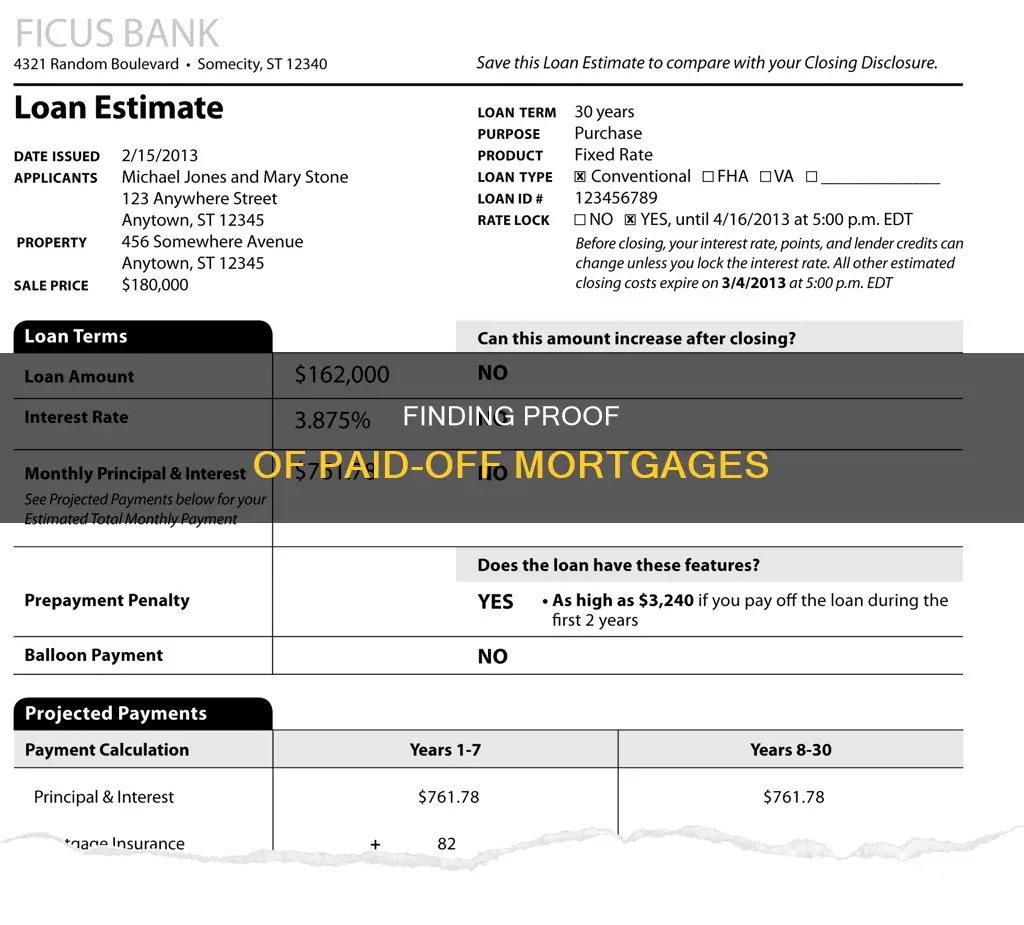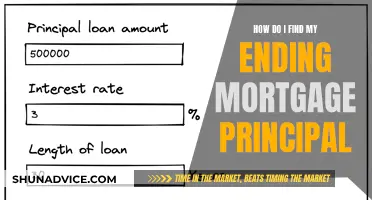
Paying off your mortgage is a huge milestone, but it's not quite the end of the story. It's important to get the right documents to prove that your mortgage is paid in full, and to make sure that the lien on your property is released. The documentation you receive will depend on your lender, but you should expect to receive a paid-in-full letter, a final mortgage statement, and a Release of Lien. Keep these documents safe, as you may need them if you apply for a new loan or encounter issues with your credit report. If your lender doesn't automatically release the lien, you may need to take steps to file it yourself. You can find information on property records by contacting your local Secretary of State or county recorder of deeds.
| Characteristics | Values |
|---|---|
| Proof of mortgage payoff | Paid-in-full letter, final mortgage statement, canceled note, Release of Lien |
| Lender's responsibility | To provide documentation, file a document releasing the lien on the property |
| Borrower's responsibility | To keep proof of payoff, contact insurance company, follow up with the lender if lien not released |
| Additional documents | Most current loan statement, original promissory note, Closing Disclosure form, deed, title insurance policy |
| Public record | Varies by location, some information may be available on local property appraiser's website |
What You'll Learn

Lender's paid-in-full letter
A paid-in-full letter is a crucial document that confirms that you have fulfilled your financial obligations and that you are no longer obligated to your creditor. It is a simple letter from your lender that states you have satisfied your mortgage agreement and don't owe any more money. It also acts as proof that insulates you from any collection agency coming after you.
Lenders typically send this letter automatically after receiving your final payment. However, given the importance of this document, you should be prepared to send a request to your lender if they don't send it. You can also use this letter to fight any inaccuracies on your credit report.
A paid-in-full letter is one of several documents that prove you have paid off your mortgage. Other documents include the property deed, which shows who the rightful owner of the house is, the cancelled note, a final mortgage statement, and a Release of Lien. The Release of Lien is especially important as it shows that you own the property without anyone else laying claim to it. However, not all lenders file the Release of Lien with the county, so you may have to do this yourself.
To request a paid-in-full letter, you should send a written request to your lender. Make sure to include the date, your name, address, phone number, account number, and a statement that your debt has been paid in full. You can also request that the debt collector or original creditor responds with written confirmation.
Finding Assumable Mortgages: Strategies for Success
You may want to see also

Canceled note
A canceled note is one of the documents that prove you have paid off your mortgage. It is a promissory note, which is a negotiable instrument. The person or company holding the note has the right to collect the payments due on the note. Typically, the lender would return the note and mortgage stamped "canceled" once the homeowner had paid off the loan. However, in the digital age, lenders tend to avoid handling original documents and may not return them.
The canceled note is one of several documents that prove you have paid off your mortgage. Others include a paid-in-full letter, a final mortgage statement, and a Release of Lien. The Release of Lien is especially important because it shows that you own the property without anyone else laying claim to it. However, not all lenders file the Release of Lien with the county, so you may have to do this yourself.
You can also prove you have paid off your mortgage by checking your credit report, which should show that the loan was paid in full. You should also have a statement from the bank showing that you no longer have a balance on the loan.
If you are applying for a new mortgage, your new lender should be able to tell you if there is any documentation you will need to provide relating to your old loan. If you are having trouble finding proof that you have paid off your mortgage, you can also contact the company that paid off your loan to find out if the lien was released.
Finding an Old Mortgage Account: Tips and Tricks
You may want to see also

Final mortgage statement
A final mortgage statement is a document that shows you have fully paid off your mortgage and now own your home. It is one of several documents that your lender should send you after you have made your final payment. This statement will show that you don't owe any principal, interest or fees.
The final mortgage statement is free and easy to obtain, and it is important to keep it as proof of full repayment. It is also useful to have this document to hand if you are applying for a new loan, proving to the insurance company that you have paid off your loan, or for any other reason that requires proof.
The other documents you may receive include a paid-in-full letter, which is a simple statement that you have satisfied your obligation and don't owe any more money. You should keep this letter, as it can be useful if the credit bureaus don't update your credit report with the correct information. You may also receive a cancelled note, which is a document stating that a promise to pay has been nullified, and a Release of Lien, which shows that you own the property and no one else can lay claim to it.
It is important to note that not all lenders will automatically file the Release of Lien with the county, so you may need to do this yourself. You can also contact the company that paid off your loan to find out if the lien was released, but note that there may be a delay between the time you pay off your mortgage and the release of the lien.

Release of lien
A release of lien is a document that shows that you own your property without anyone else having a claim on it. When you take out a mortgage, the lender will file a lien against your property, which gives them the right to foreclose on your home if you stop making payments. Once you have paid off your mortgage, the lender no longer has a lien on your property, and you will need to obtain a release of lien document.
There are a few ways to obtain a release of lien. One way is to contact your lender and request the document. The lender should provide you with documentation showing that you have satisfied your mortgage agreement, such as a paid-in-full letter, cancelled note, or final mortgage statement. You can also contact the company that paid off your loan to find out if the lien was released. Keep in mind that there may be a delay between paying off your mortgage and the release of the lien.
Another way to obtain a release of lien is to check with your local county recorder of deeds or secretary of state. The lender should have filed a document releasing the lien on your property with the office that handles real estate filings in your area. If the document was not sent to this office, it may have been mailed to you for filing or recording. You can also check your own files to see if the lender sent you the release papers, which may include the cancelled note and mortgage along with the release of lien.
It is important to keep a copy of the release of lien for your records. This document may be needed when applying for a new loan or proving to an insurance company that you have paid off your previous loan. The release of lien is also important because it shows that you are the rightful owner of the property and have the legal right to sell it.

State property records
- Release of Lien: This document is crucial as it demonstrates that you own the property without anyone else having a claim on it. However, not all lenders will automatically file the Release of Lien with the county. It is your responsibility to ensure that this document is properly filed. You can contact your local Secretary of State or county recorder of deeds to obtain information on property records and confirm whether the lien has been released.
- Paid-in-Full Letter: After you make your final mortgage payment, your lender should send you a letter stating that you have satisfied your obligation and no longer owe any money. Keep this letter, as it can serve as proof of payment in case there are discrepancies in your credit report.
- Final Mortgage Statement: This document indicates that you have fulfilled your mortgage agreement. It may be provided by your lender or obtained from the county recorder's office.
- Cancelled Note: This document signifies that the terms of your mortgage agreement have been met, and it may be included in the release papers sent by your lender.
- County Recording Office: The county recording office plays a vital role in confirming the release of the lien. Your lender should contact this office and provide documentation proving that you have satisfied the lien. You can also take proactive steps by contacting the county recording office yourself and providing proof of mortgage payment.
- Credit Report: Your credit report should reflect that your mortgage loan has been paid in full. Ensure that the loan number on your credit report matches the loan number on any documentation you possess.
Remember that the availability and specifics of state property records may vary depending on your location. It is always a good idea to consult official sources, such as government websites or your local Secretary of State, for the most accurate and up-to-date information.
Frequently asked questions
Your lender should provide you with a document showing that your mortgage is paid off. This could be a paid-in-full letter, a final mortgage statement, or a Release of Lien. You should keep this document as proof of payment. If your lender does not provide this, you should contact them to request it.
You may also receive a cancelled note, a copy of the satisfaction of the mortgage, or the original promissory note with the marking "paid and canceled".
You can check your credit report to see if the loan has been marked as paid in full. You can also check your local property appraiser's website to see if there is information about your ownership of the property.







